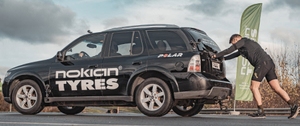Nokian tires set a new world record in pushing a car
Nov 16, 2020
A new Guinness World Record for pushing a car per mile (1.6 km) has been set in Finland. The record was set by Jussi Kallioniemi, who says this is not a test of brute strength, but rather a complex puzzle. A key element of this record is the Nokian Hakkapeliitta R3 (SUV) winter tire, which offers extremely low rolling resistance.
13 minutes and 26 seconds - this is how much time it took for Jussi Kallioniemi from Nokia to push a passenger car weighing 2,100 km over one mile (or, to be more precise, 1,609.34 meters) and set a new world record. This result surpasses the previous record by almost two minutes. The Guinness Book of Records officially confirmed the world record as "The fastest time it takes to push a car one mile."
The record was set on Saturday 24 October 2020 at the Nokian Tires Proving Ground in Nokia, Finland. For the record, Jussi Kallioniemi used his own car, a 2006 Saab known as the "Röhkö". Nokian Tires Customer Support Manager Matti Morrie was driving.
“People say that I do not look like a strong man and, believe me, I am not. It was a performance comparable to a middle distance run, not a show of strength. " Jussi Kallioniemi says that you can achieve the level of strength you need using two methods: either increase your own strength, or decrease resistance.
It is important to overcome the resistance when pushing the car, so the lower the rolling resistance of your tires, the easier the car will roll. Rolling resistance refers to the energy consumed by the deformation of the tire during contact with the road. This is also important for regular drivers. A low rolling resistance tire is an environmentally friendly and economical choice.
“Even older cars equipped with safe and studless premium winter tires like the Nokian Hakkapeliitta R3 can roll with ease on the road. Provided tire pressure is monitored, using tires with low rolling resistance can save up to 0.5 liters of fuel per 100 km or significantly increase the mileage of an electric vehicle. At the same time, you are saving the environment with lower CO2 emissions, ”says Matti Morrie.
Wellness and problem solving
The idea to push the car came up by accident. Jussi Kallioniemi suffered from back pain and was doing rehabilitation therapy pushing a heavy box in the gym. At some point, he started thinking about what else he could do and came across a brilliant idea of pushing cars on the Guinness Book of Records website.
Jussi Kallioniemi argues that it is not important to come first in the race. It is necessary to be able to solve problems as they come, to see a wider picture of what is happening. In some ways, he is really right, because thanks to the record, a new invention appeared, for which a patent application has already been filed. Together with his friend Jussi Kallioniemi, he created a remote control that allowed him to turn the steering wheel by himself during training without a driver.
“If it was just brute strength, I wouldn't have the motivation to see it through. In my case, everything is based on finding and solving problems. Even when you intend to work to the limit, it is important to be able to find a way to lighten the burden by at least one or two percent, ”says Jussi Kallioniemi.
Commitment to development
Jussi Kallioniemi trained at the Nokian Tires Proving Ground in Nokia, Finland. The head office of the concern is also located there. Jussi and Nokian Tires have one thing in common.
Matti Morrie: “Our passion for tire design is similar to Jussi's passion for training. We test our tires extensively under extreme conditions. For us, the focus is on the calmness of the driver behind the wheel. "
Record Setting Information
Many types of data were used and collected in establishing the recor. The project was attended by Myontec Oy, which specializes in smart clothing and muscle monitoring, and Polar Electro Oy, which manufactures sports electronics.
“It was easy for us to get involved in the project as we saw good all-round preparation. Over the years, Polar products have been used in space and in Formula 1 racing cars, so trying to set the record looked like a big challenge, ”says Polar's manager Ville Uronen.
Jussi followed his plan exactly and didn't start too hard. The data obtained with the Jussi's multi-sensor performance meter was examined in real time.
Jussi's maximum heart rate during the performance was very low, only 164 beats per minute, despite the fact that the speed temporarily increased in the first 100 meters and reached 10.4 km / h. Muscle activity was approximately 41% of the measured maximum value. Around the middle of his performance, Jussi used 35% of his muscle strength.
“Setting the world record gives me a boost of energy and pleasure. I feel like the last piece of the puzzle is in place,” says Jussi Kallioniemi.
